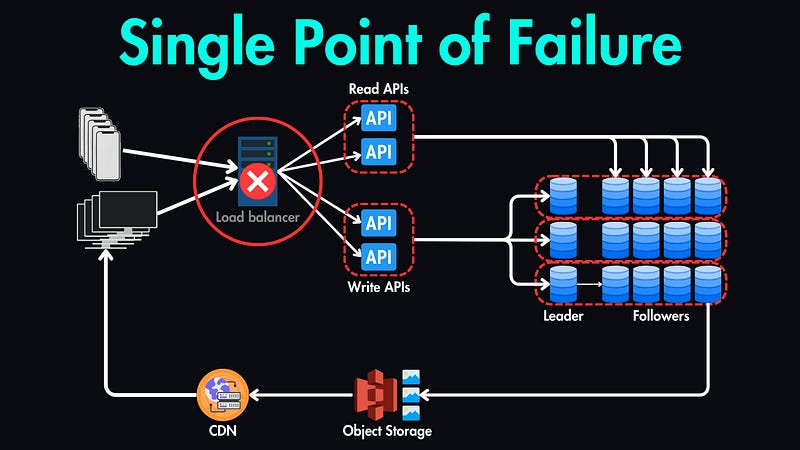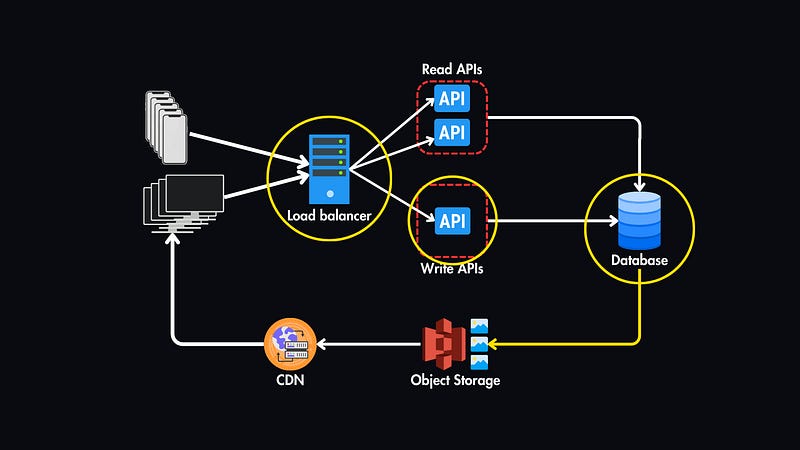Single Point of Failure (SPOF) in System Design
Learn what a Single Point of Failure (SPOF) is, why it matters in system design, and how to eliminate it for more reliable systems.
What is a Single Point of Failure?
A single point of failure (SPOF) is a part of a system that, when it fails, brings the entire system down.
In simple terms, it’s any component that could cause the whole system to fail if it stops working.
For example, if you have a web application where the database is on a single server.
If that server goes down, your whole application becomes unavailable, impacting user experience and potentially leading to data loss.
Why is SPOF a Problem in System Design?
Single points of failure are problematic because they create vulnerabilities. In complex systems, it’s especially crucial to identify and mitigate them to ensure reliability and resilience.
When we remove SPOFs, we reduce downtime risks, protect data, and help our system scale.
Let’s look at a few reasons why SPOF is such a significant concern:
Reliability: A single failure can take the entire system down, which could mean business losses and user dissatisfaction.
Scalability: Systems with SPOFs often struggle to scale, as each component adds risk.
Security: A single vulnerable entry point makes it easier for attackers to compromise the whole system.
Common Single Points of Failure in Systems
To design around SPOF, it helps to understand where they typically occur. Let’s go over some frequent single points of failure in system design:
Databases: Often, the database is the backbone of an application. If it’s set up on a single server without replication, any failure can take the application offline.
Load Balancers: While load balancers are supposed to improve reliability, if there’s only one and it fails, your entire system can go down.
Application Servers: When applications run on a single server, the whole service goes offline if that server fails.
Network Connections: Single network links create SPOFs. For instance, if your only connection to the internet fails, users can’t access your system.
Strategies to Eliminate Single Points of Failure
Now, let’s discuss ways to design systems that minimize or eliminate SPOFs. These strategies enhance resilience and scalability, making systems more robust.
Redundancy
One of the best ways to eliminate SPOF is through redundancy, where we duplicate critical components. This can be done by setting up multiple instances of databases, load balancers, and servers.
Example: With multiple database replicas, if one fails, the others keep the system running.
Failover Mechanisms
Implement automatic failover for critical services. This means if one component goes down, a backup takes over immediately.
Example: For API servers, consider implementing failover options where a standby takes over if the primary server fails.
Load Balancing
A load balancer itself can be a SPOF, so consider deploying multiple load balancers in a failover configuration.
Example: In case one load balancer fails, traffic is seamlessly routed through another.
Geographic Distribution
For systems with global reach, consider distributing servers across regions. This prevents location-based failures from affecting the whole system.
Example: Using a Content Delivery Network (CDN) to distribute static assets globally can reduce dependency on a single server.
Monitoring and Alerts
Continuously monitor systems and set up alerts to detect failures early. This helps address issues before they impact end users.
Example: Use monitoring tools to track system health and receive alerts when performance metrics fall below acceptable levels.
Common Mistakes When Addressing SPOF
Even experienced designers can make mistakes when handling SPOFs. Here are a few common ones to watch out for:
Overlooking the Load Balancer: Many assume adding a load balancer solves SPOFs, but if there’s only one, it becomes a SPOF itself.
Neglecting Failover Testing: Setting up backups without testing can lead to unexpected failures when they’re needed.
Ignoring Monitoring: Without monitoring, it’s impossible to detect and react to failures effectively. Monitoring is key to making redundancy and failover work in practice.
Understanding and addressing single points of failure is crucial for designing robust, scalable systems.
By identifying SPOFs and implementing redundancy, failover, and monitoring, you can build systems that withstand unexpected failures and maintain a positive user experience.
Want to level up your system design skills with my personal guidance? Join our community and gain access to weekly lessons, real-world examples, and hands-on guidance.

















